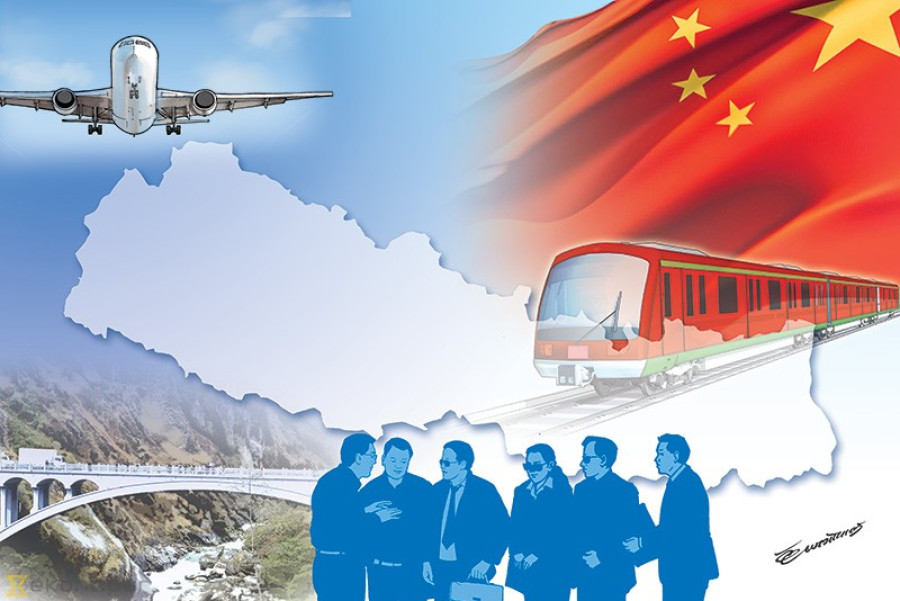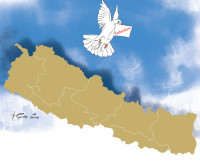Opinion
Rough road ahead
From land acquisition to hiring of personnels-challenges abound to implement contracts under the BRI
Bipin Adhikari & Bidushi Adhikari
Nepal and China have shared close bilateral ties for many years, reinforced by mechanisms such as the Joint Consultation Mechanism and the Nepal-China Inter-Governmental Economic, among others. After the first ‘economic aid’ ties in October 1956, China has risen to become one of the leading investors in Nepal. For the third consecutive fiscal year, in 2018, China topped the foreign direct investment ranking in Nepal, accounting for 84 percent (approximately $427 million) of the total investment. Since 2013 and as of December 2018, Nepal and China have signed contracts for investment in Nepal amounting to $3.32 billion.
While western investors have generally viewed Nepal’s political instability and its rugged terrain as challenges to investments in infrastructure, Chinese investors have deemed Nepal adequate for investment ‘because of investment-friendly policies from government side.’As Nepal continues to sign and expedite major projects under the Belt and Road Initiative (BRI) in the ‘hydropower generation, manufacturing, river training and agricultural industries,’ for example, it is especially important to evaluate how infrastructure projects have fared in Nepal and what kinds of challenges they face in upholding the terms of the contract, progressing, and meeting deadlines.
Political and geopolitical challenges
According to Deloitte’s analysis of BRI projects and their conversations with BRI clients, political risks top the other risks associated with the implementation of contracts for BRI projects. Deloitte suggests that this risk can be mitigated by understanding and overseeing the stability of the host country’s government through the duration of the projects. Such political instabilities are true of Nepal as well. For example, in late 2017, the $2.5 billion Budhi Gandaki hydropower project was scrapped by the government. The cancellation followed a change in the leading party of government from the Maoist-led government, although a lack of efficiency was attributed as one of the reasons for the cancellation. Political interests will no doubt play a role in the future as well, as governing parties’ priorities change.
Delays in the decision-making process are another major issue that threatens the productivity of infrastructural investments. As of late 2018, the Chinese government was still waiting on approval from the Department of Roads in Nepal to move forward with the second phase of the Ring Road expansion project. Delays from the Chinese side have also been an issue, as has been the case with Kulekhani-3 Hydropower Project.
In the same vein, Nepal’s increasingly close ties with China threaten to change the geopolitics of South Asia. After India-funded projects that failed to be completed, including road and hydropower projects, China has presented itself as a reliable partner for investment in infrastructure, including gifting a new training academy in 2018 for Nepal Armed Police Force, previously a project claimed by India. China promotes a narrative of unity in South Asia, supposedly to downplay the tensions between the two countries, and has asked India to join China in investing in infrastructural projects in Nepal.This type of proposition has hardly come from India; while China has promoted the connectivity of the China-Nepal-India economic corridor, India has generally been wary of the project.
At the European Business Summit held in the first half of the 2018, the European delegation raised the issue of transparency of China-funded projects so that European companies can apply for projects and also ensure their sustainability. According to Nikkei Asian Review, 89 percent of contractors participating in Chinese-funded transportation projects are actually Chinese. In contrast, projects funded by multilateral agencies such as the World Bank and the Asian Development Bank are much more diverse, with 29, 40.8, and 30.2 percent contractors that are Chinese, local, and foreign, respectively.
Currently, the Budhi Gandaki Hydropower Project is only at 9.9 percent in terms of physical progress and financial progress is only 10 percent. The compensation of land acquisition to the displaced is still underway in various areas of the project, namely Arughat Bazar of Gorkha and Khahare Bazar of Dhading district. Critics quickly pointed out that the project should have undergone a competitive, international bidding process. The lack of a competitive tendering process can hurt the efficiency of the projects and the opportunities for local contractors as well as violate local tendering laws. Many things depend on the goodwill of the host government.
Contractual disputes
Patrick M. Norton, an independent arbitrator based in New York City, argues that there are two basic sets of contracts (performance agreements to construct infrastructure and underlying financial agreements) that BRI infrastructure projects will require.Various parties, including will undoubtedly become involved in the projects during and much after the construction. To resolve contractual disputes arising from such joint ventures, Norton suggests a government-to-government mediation process, judicial resolutions (for example cases involving local laws in the areas of tax and real estate disputes), and arbitration (which will require a venue and an institution for administering the process).
China enjoys a competitive advantage because oftentimes, it offers the cheapest alternative. However, some glaring issues may arise once the contract has been awarded, including quality assurance, speediness of the work, and meeting deadlines. These issues may lead to the violation of the terms of the contract between the parties as well. This was true for the Guangxi Transmission and Substation Construction Company, the contractor responsible for the first section of the Tamokoshi-Kathmandu Transmission Line Project. The issue of land acquisition spills into the issues of resettlement and rehabilitation of populations that would be displaced by the projects. In August 2018, Nepali authority expressed that the West Seti Hydropower Project was financially unfeasible due to the high costs of rehabilitation and resettlement..
Issues relating to personnel can also hinder the progress of the projects, causing continued delays. For example, during the construction phase of the Upper Marsyangdi ‘A’ Hydropower Project in Lamjung, workers belonging to trade unions held multiple strikes and sit-ins when the authorities did not heed their demands for minimum wages, retirement benefits, life insurance, and leaves. They also claimed to have been unfairly compensated when compared with their Chinese counterparts and asked for the dismissal of a Chinese foreman accused of ‘manhandling the workers.’ Chinese laborers are supposedly preferred over local laborers due to the language barrier and the finer skill level of Chinese laborers. Similarly, Chinese contractors tend to import from China the materials necessary for construction; this could further increase Nepal’s trade deficit.
As Nepal hopes to secure more investment in infrastructural projects in Nepal from China, it is important to carefully evaluate these challenges and find ways to combat them effectively. Even after projects have been completed, their functioning could be delayed further. It is important for project stakeholders to maintain the terms of the contract and resolve arising issues through arbitration and mediation, as litigation can cost both parties unnecessary capital. It is in the best interest of the country to ensure progress via quick resolutions of arising conflicts, such as those mentioned previously.
Bipin Adhikari is a constitutional expert. Bidushi Adhikari is associated with Nepal Consulting Lawyers, Inc as a research assistant




 13.12°C Kathmandu
13.12°C Kathmandu

.jpg&w=200&height=120)







%20(1).jpg&w=300&height=200)

